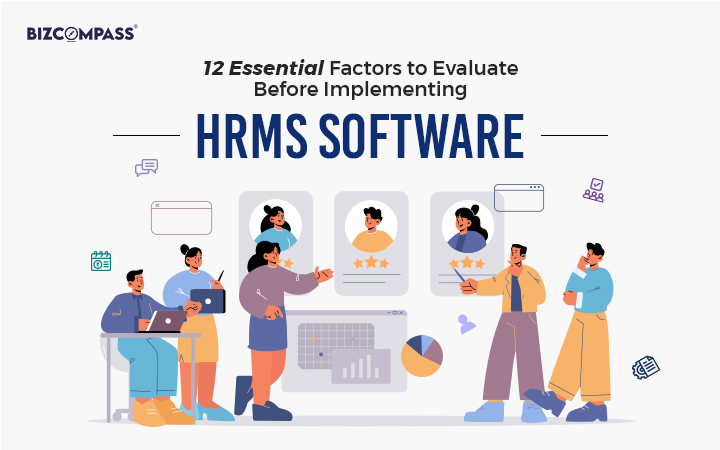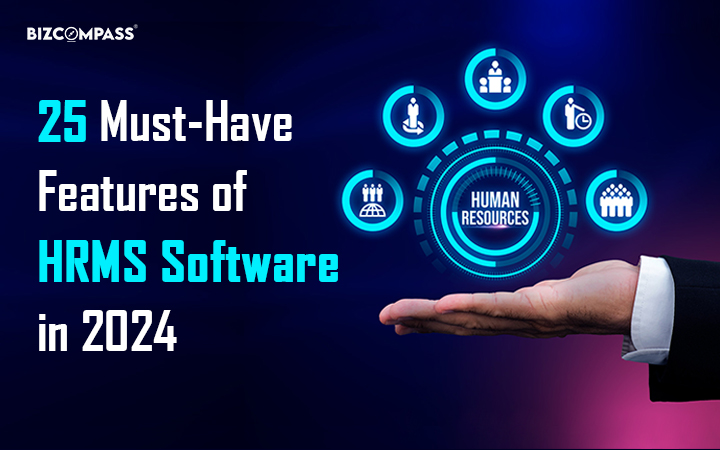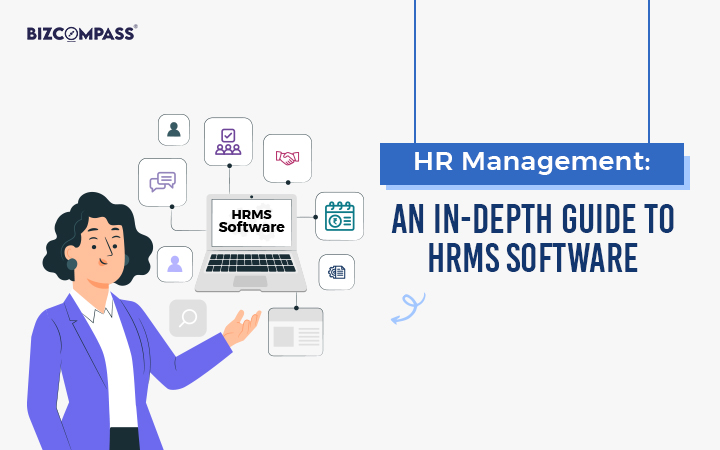Introduction
In the dynamic realm of modern HR management, technology plays a pivotal role in reshaping traditional practices. At the forefront of this digital transformation is Human Resource Management System (HRMS) software—a robust solution that integrates and revolutionizes HR processes.
This blog explores the core of HRMS effectiveness, dissecting the ten key components that propel organizations toward streamlined, efficient, and data-driven human resource management.
From talent acquisition to analytics, each component contributes to a comprehensive system designed to meet the intricate demands of today's businesses.
Join us on this journey as we uncover the essential elements shaping the future of HRMS software.
In the contemporary landscape of Human Resources (HR) management, technology has emerged as a transformative force, reshaping the traditional paradigms of workforce administration.
The increasing role of technology in HR management reflects a fundamental shift from manual and time-consuming processes to streamlined, efficient, and data-driven practices. Technology is no longer a mere facilitator but an indispensable partner, enhancing every facet of HR functions.
Automation has become a linchpin in HR processes, drastically reducing the burden of administrative tasks. From applicant tracking systems streamlining recruitment processes to advanced analytics offering insights into employee performance, technology is catalyzing efficiency and informed decision-making.
Cloud-based solutions facilitate real-time collaboration, enabling HR professionals to transcend geographical boundaries and work seamlessly across diverse locations.
The significance of HRMS (Human Resource Management System) software lies in its role as a comprehensive solution that unifies diverse HR functions. Serving as a digital hub, HRMS seamlessly integrates employee data management, payroll processing, talent acquisition, and more.
This all-in-one platform eliminates silos, fostering efficient collaboration and data accuracy. With a holistic approach, HRMS empowers organizations to streamline operations, make informed decisions, and adapt to evolving workforce dynamics. Its comprehensive nature not only saves time and resources but positions HR teams to proactively address the multifaceted needs of the modern workplace.
Core Employee Management Components In HRMS
Discover the employee management components essential for HRMS software. From talent acquisition to analytics, explore the key features shaping efficient workforce administration in the digital age.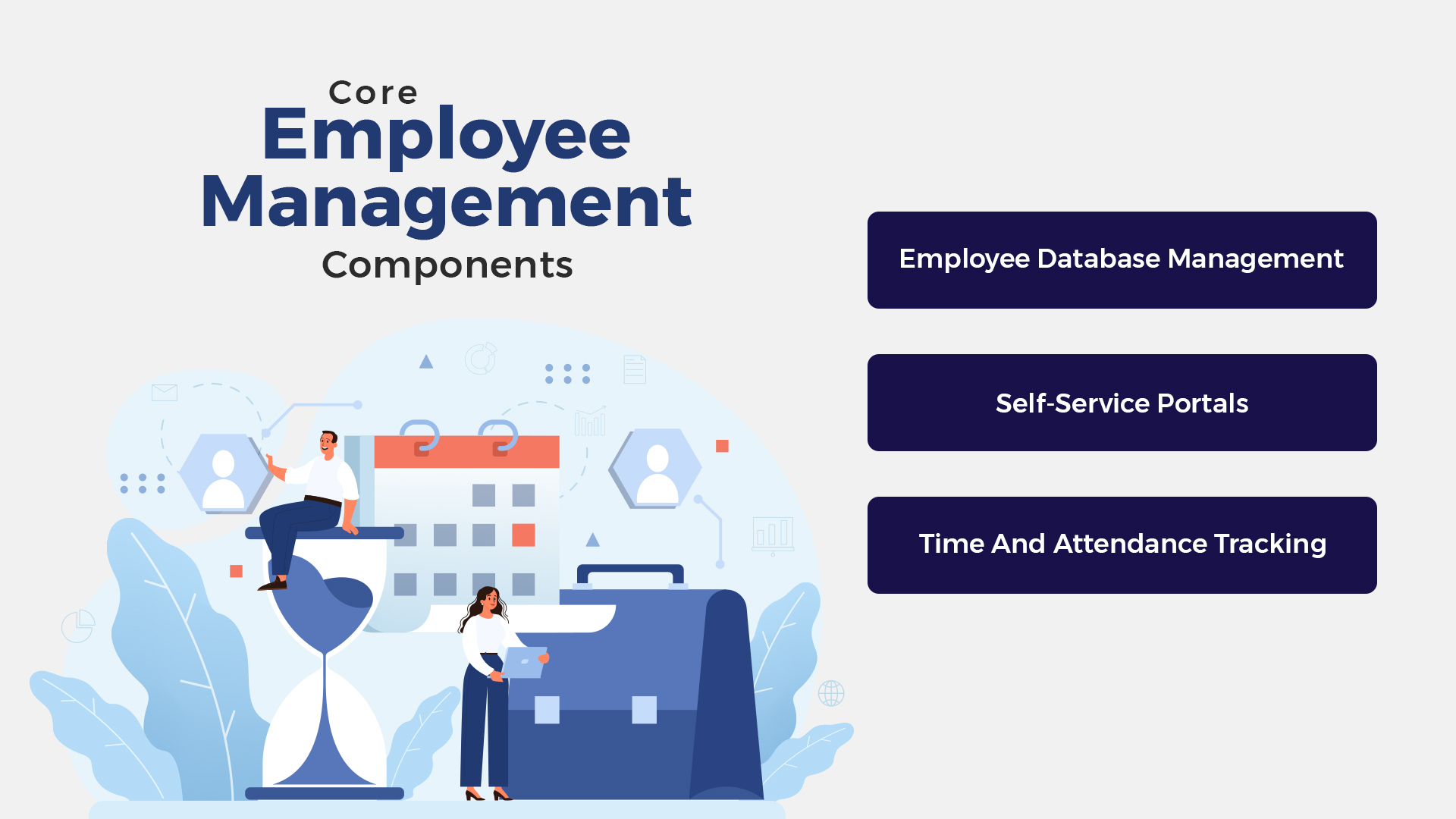
Employee Database Management
In the realm of the Human Resource Management System, a centralized employee database is a cornerstone for effective workforce administration. It serves as a comprehensive repository, consolidating critical employee information into a centralized hub.
This centralized approach ensures accuracy, consistency, and accessibility, laying the foundation for streamlined HR processes. The benefits of easy access to employee information are manifold.
HR professionals can swiftly retrieve and update personnel records, facilitating efficient onboarding, performance evaluations, and compliance management.
Instant access to historical data empowers decision-making, allowing for data-driven insights into employee performance and trends. Moreover, a centralized database enhances collaboration across departments, fostering seamless communication and coordination.
This accessibility not only saves time but also ensures that HR teams are equipped with real-time, accurate information, enabling them to respond promptly to employee needs and organizational requirements. In essence, the ease of accessing a centralized employee database is a linchpin for optimizing HR operations, promoting transparency, and enhancing the overall efficiency of workforce management within the organization.
Self-Service Portals
Self-service portals in HRMS empower employees with features like personal information updates, leave requests, and access to pay stubs, streamlining administrative tasks.
These self-service options empower employees, fostering autonomy and efficiency. With the ability to manage personal data and initiate requests independently, employees experience streamlined processes, reducing dependency on HR.
This not only enhances satisfaction but also contributes to a more agile and responsive organization, where employees have the tools to actively participate in their own HR management, promoting a culture of self-reliance and engagement.
Time And Attendance Tracking
Time and attendance tracking in HRMS automates the recording of employee work hours, absences, and attendance, ensuring precision in workforce management. Automated tracking enhances accuracy by eliminating manual errors, and providing real-time data on employee attendance. This not only streamlines payroll processes but also boosts efficiency, allowing HR professionals to focus on strategic initiatives rather than tedious administrative tasks.
With precise time tracking, organizations gain insights into workforce productivity and compliance, fostering a more efficient and accountable work environment.
The automation of time and attendance management stands as a testament to the transformative power of technology in optimizing HR operations.
Recruitment And Onboarding Components
Recruitment and onboarding components in HRMS streamline talent acquisition, from posting vacancies to seamless employee integration. Automated workflows enhance efficiency, ensuring a smooth onboarding experience. With features like applicant tracking and digital onboarding, HRMS simplifies the hiring process, accelerating time-to-productivity for new hires and optimizing overall recruitment.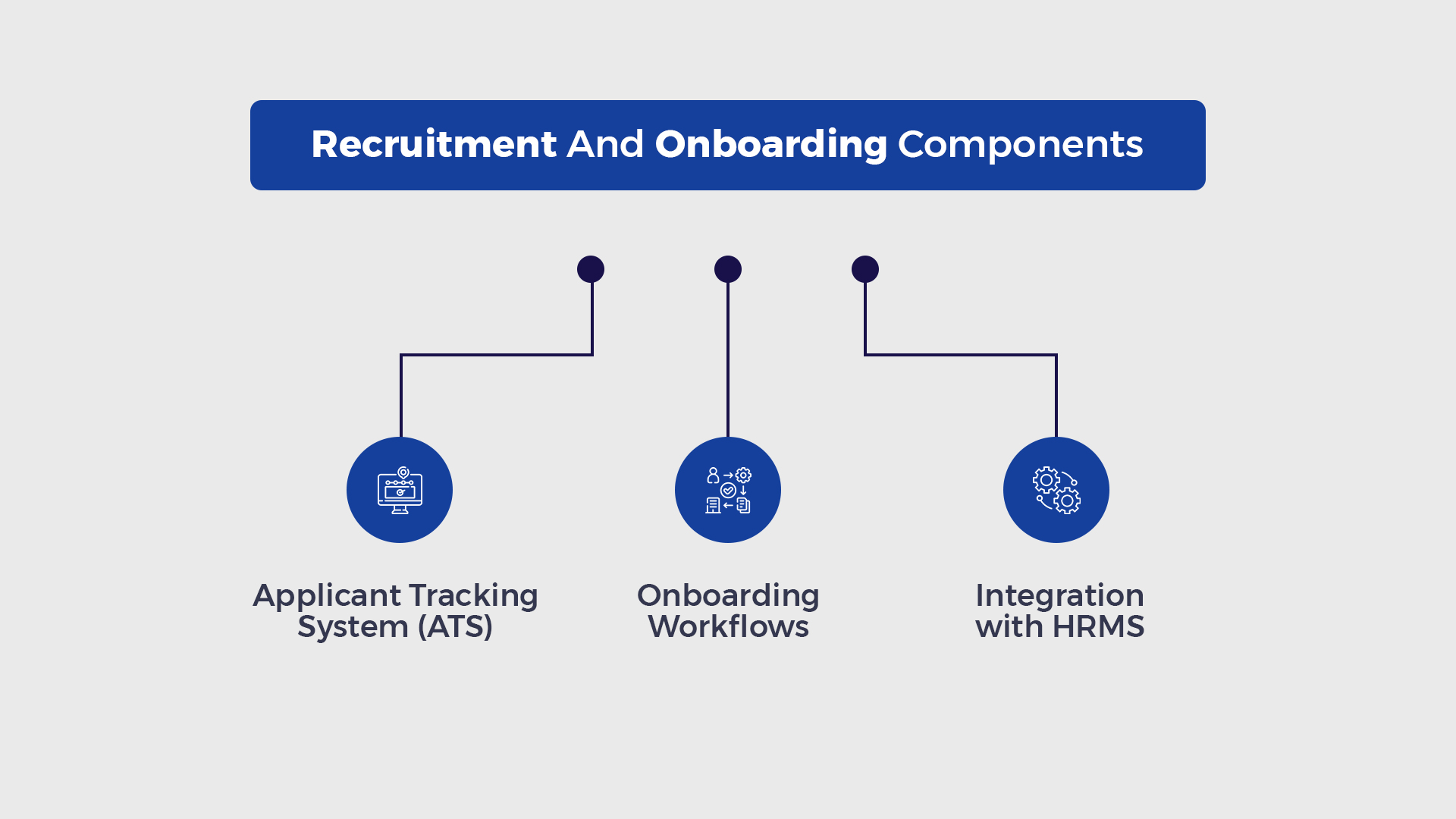
Applicant Tracking System (ATS)
The Applicant Tracking System is a pivotal recruitment tool that revolutionizes the hiring process. Serving as a centralized hub, ATS efficiently manages job postings, organizes applications, and facilitates the entire hiring lifecycle. It automates resume screening, allowing HR professionals to sift through a vast pool of applicants effortlessly.
ATS also ensures compliance with hiring regulations and promotes a seamless collaboration between hiring teams. With its ability to track candidate progress and streamline communication, ATS not only accelerates recruitment but also enhances the overall quality of hires, making it an indispensable asset for modern HR strategies.
Onboarding Workflows
Onboarding workflows in HRMS are pre-designed sequences automating the orientation of new hires. These workflows guide HR professionals through essential tasks like document submission, training schedules, and equipment allocation, ensuring a structured onboarding experience.
Streamlined onboarding processes enhance efficiency, reduce manual errors, and accelerate time-to-productivity for new employees. The benefits extend to improved employee satisfaction, compliance adherence, and a seamless transition into company culture, fostering a positive and lasting impression. HRMS-driven onboarding workflows are a strategic asset, aligning the onboarding journey with organizational goals and contributing to robust employee integration.
Integration with HRMS
Integrating recruitment data with HRMS is paramount for a cohesive HR strategy. Seamless data transfer ensures a unified platform where recruitment seamlessly transitions into HR management. This integration eradicates data silos, enhancing accuracy and eliminating redundancies in processes. Real-time access to recruitment insights within HRMS empowers decision-making, from onboarding to ongoing employee management.
The advantages encompass improved collaboration between HR and recruitment teams, reduced manual effort in data entry, and a holistic view of the employee lifecycle. In essence, integration optimizes the synergy between recruitment and HR functions, fostering a more efficient, data-driven, and comprehensive approach to human resource management.
Performance Management Components
Performance management components in HRMS facilitate objective employee evaluations, goal tracking, and feedback mechanisms. These tools streamline the appraisal process, promoting transparency and alignment with organizational objectives. With features like continuous feedback and performance analytics, HRMS ensures a data-driven approach to enhancing individual and workforce performance.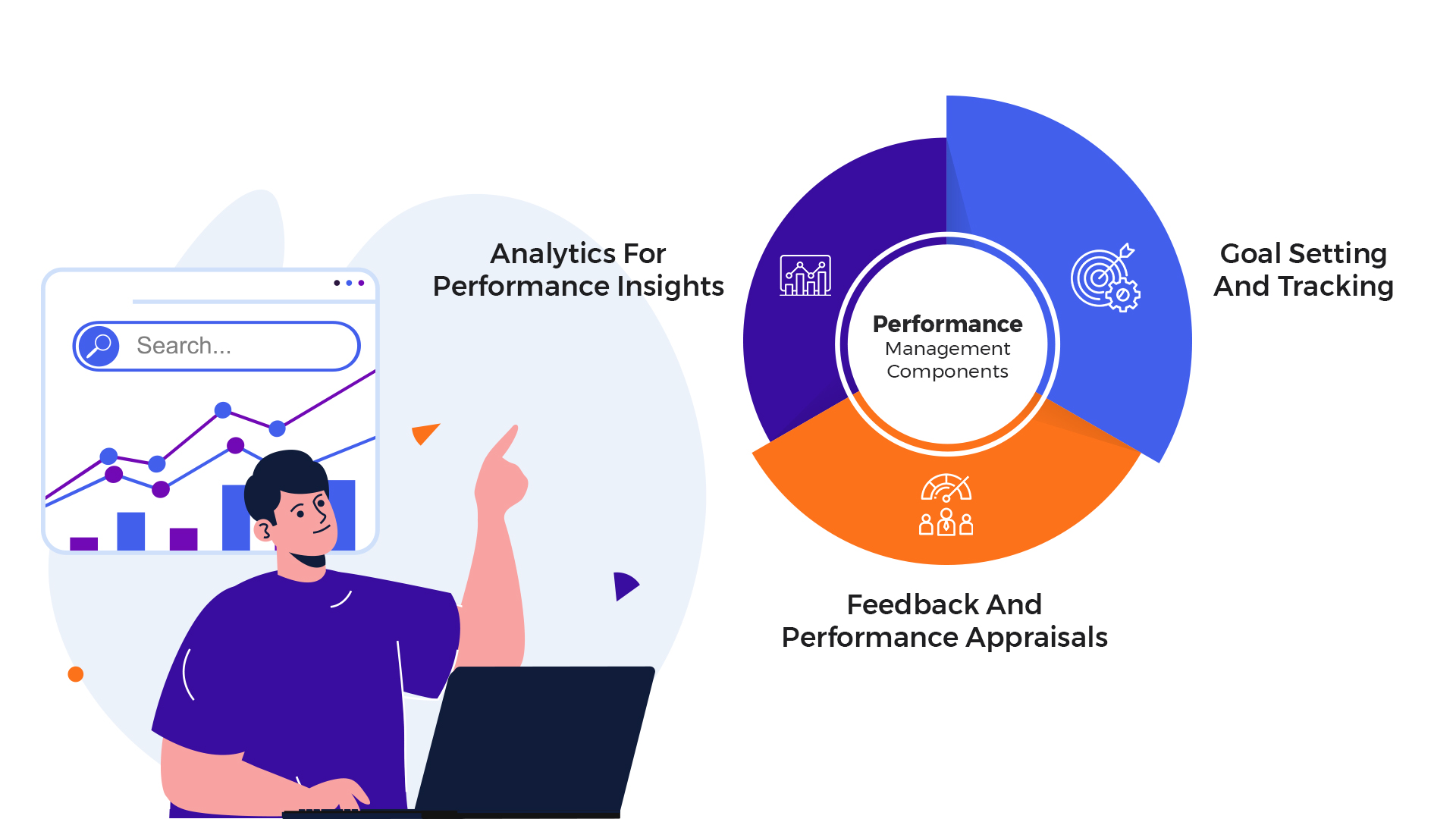
Goal Setting And Tracking
In HRMS, goal-setting and tracking features empowers organizations to set, monitor, and evaluate employee objectives. This functionality ensures clarity in expectations and promotes goal alignment with overarching organizational objectives.
By facilitating continuous tracking and feedback, HRMS enhances individual performance, fosters employee development, and strengthens the overall organizational strategy.
The alignment of individual goals with broader objectives not only enhances workforce productivity but also contributes to a more cohesive and goal-driven organizational culture, where every employee's efforts are strategically aligned with the company's mission and vision.
Feedback And Performance Appraisals
HRMS facilitates continuous feedback by offering a structured mechanism for ongoing communication between employees and managers. This feature ensures timely recognition, correction, and improvement of performance, fostering a dynamic work environment.
Additionally, the software streamlines the performance appraisal process by automating data collection, analysis, and reporting. It provides a centralized platform for evaluating employee achievements and areas for development. This not only reduces administrative burden but also promotes fairness and transparency in performance assessments.
The integration of continuous feedback and performance appraisals within HRMS reflects a commitment to fostering employee growth and organizational excellence.
Analytics For Performance Insights
Analytics in HRMS tracks performance metrics, providing a data-driven approach to performance evaluation. This component employs advanced algorithms to analyze employee data, offering valuable insights into productivity, engagement, and key performance indicators.
By translating raw data into actionable insights, organizations gain a comprehensive understanding of individual and team performance.
This not only streamlines the performance evaluation process but also enables targeted strategies for improvement. With analytics-driven insights, HR professionals can make informed decisions, align performance goals with organizational objectives, and foster a proactive and efficient approach to managing and enhancing overall workforce performance.
Learning And Development Components
Learning and development components in HRMS facilitate skill enhancement through personalized training programs, course management, and performance tracking. These features empower organizations to nurture a culture of continuous learning, ensuring employees stay aligned with evolving industry demands and fostering professional growth within the workforce.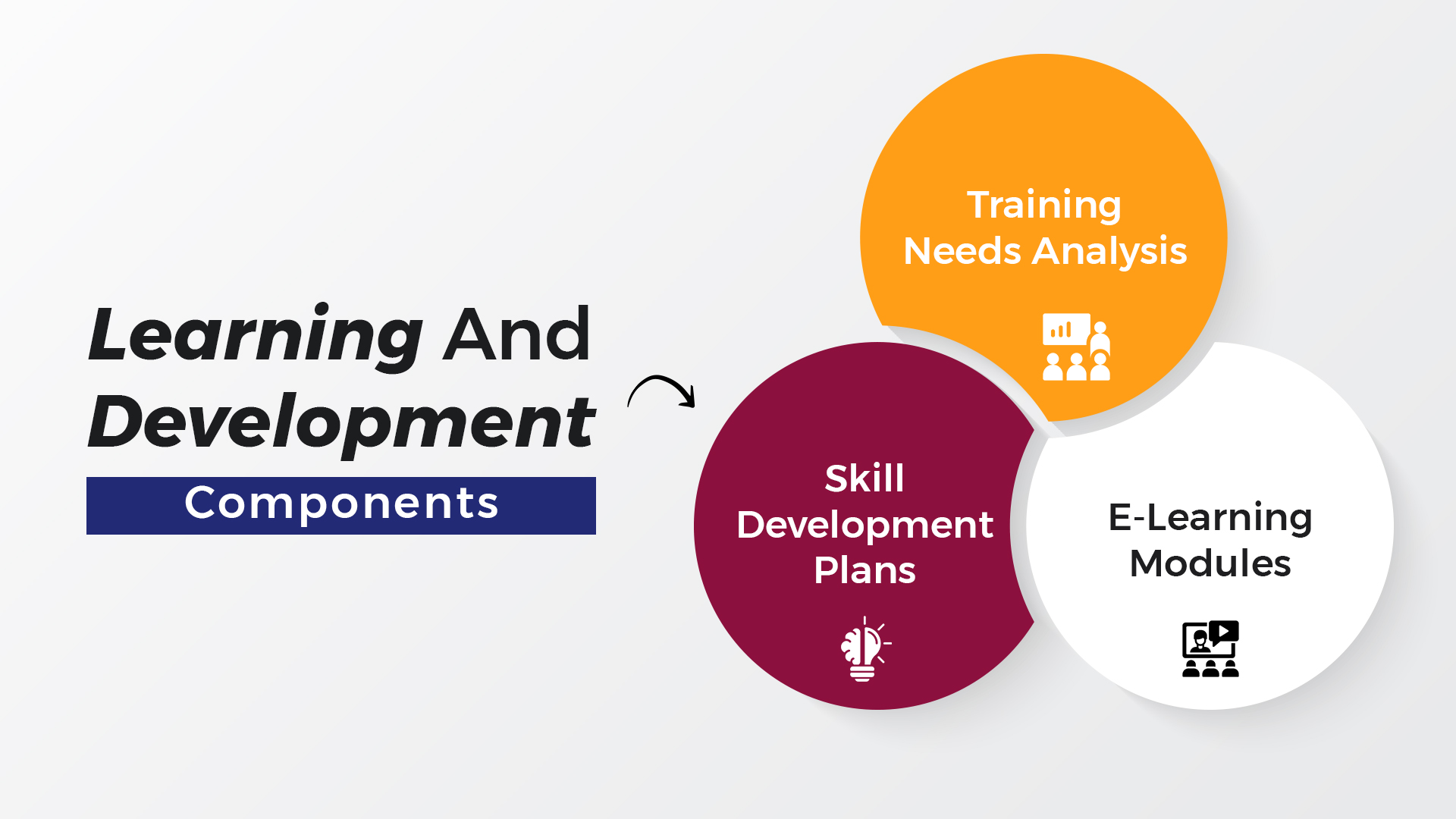
Training Needs Analysis
Training Needs Analysis, a vital component of HRMS assesses employee training needs by identifying skill gaps within the workforce. This feature systematically evaluates individual competencies against job requirements, ensuring targeted and effective training initiatives.
Identifying skill gaps is crucial as it allows organizations to address deficiencies, enhance workforce capabilities, and align training programs with strategic goals.
By pinpointing specific areas for development, HRMS ensures that training efforts are tailored to meet the evolving needs of both employees and the organization, fostering continuous improvement and maintaining a competitive edge in the ever-changing business landscape.
E-Learning Modules
HRMS integrates E-Learning Modules, providing a wealth of online training resources for employees. These modules cater to diverse learning preferences by offering interactive content, videos, and assessments. Accessible anytime, anywhere, e-learning ensures flexibility.
Employees can choose the pace and format that suits their learning style, fostering a personalized and effective learning experience. This approach not only accommodates diverse skill levels but also aligns with modern, dynamic work environments. E-Learning Modules within HRMS empower organizations to cultivate a continuous learning culture, enhancing employee skills and knowledge in a way that suits the individual preferences of the workforce.
Skill Development Plans
Human Resource Management System facilitates personalized skill development plans by tailoring training initiatives to individual employee needs.
The software assesses skills, identifies gaps, and recommends targeted learning resources. Through goal-setting and progress tracking, employees receive guidance on their learning journeys. This not only aligns professional development with organizational objectives but also empowers employees to enhance their skills at their own pace.
Skill Development Plans within HRMS ensure a strategic and customized approach to employee growth, promoting continuous learning and adaptability in the ever-evolving landscape.
Analytics And Reporting Components
Analytics and reporting components in HRMS provide comprehensive insights into workforce metrics, enabling data-driven decision-making. These features generate actionable reports on employee performance, engagement, and other key indicators.
The analytics-driven approach ensures HR professionals have a clear understanding of trends, facilitating strategic planning and optimization of human resource strategies.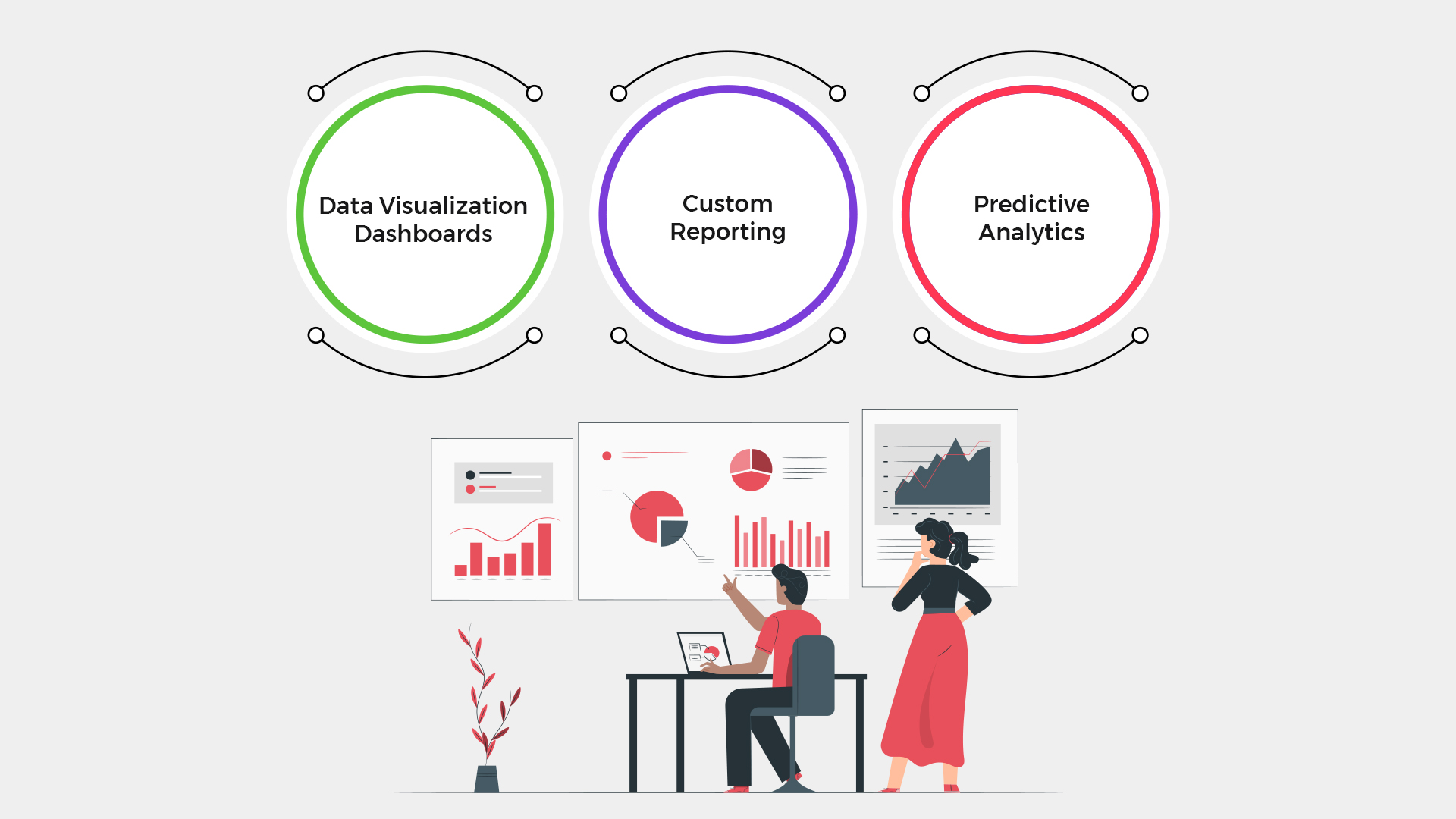
Data Visualization Dashboards
Data Visualization Dashboards in HRMS offer a user-friendly interface for gaining quick and insightful HR perspectives. These dashboards utilize visual representations of data, simplifying complex metrics into comprehensible graphics.
HR professionals can customize dashboards to cater to different user needs, providing tailored insights for executives, managers, and individual employees.
The visual format enhances data interpretation, making it easier to identify trends, assess performance metrics, and strategize workforce planning.
With customizable options, HRMS ensures that diverse stakeholders have access to relevant and visually impactful information, optimizing decision-making processes across the organization.
Predictive Analytics
Predictive analytics in HRMS software leverages historical data to forecast workforce trends. By analyzing patterns, it anticipates future outcomes related to employee performance, turnover, and skill gaps. This approach aids the HR team in strategic workforce planning, enabling them to address challenges, optimize talent acquisition, and align training initiatives with future needs.
Predictive analytics enhances decision-making by providing insights into how current HR strategies may impact the organization in the long term, fostering a more agile and future-ready approach to HR management within the ever-evolving dynamics of the modern workplace.
Custom Reporting
Custom reporting in HRMS enables the creation of tailored reports, that address specific organizational needs. This feature allows HR professionals to select and present data relevant to their unique requirements, ensuring precision and relevance.
The benefits extend to data-driven decision-making, where customized reports empower stakeholders with accurate insights. This approach enhances strategic planning, performance evaluation, and overall workforce management. With the ability to generate reports aligned with specific goals, HRMS facilitates a more efficient and targeted approach to decision-making, enabling organizations to adapt and thrive in a rapidly changing business environment.
Conclusion
In conclusion, the ten key components explored—ranging from centralized employee databases to predictive analytics—form the backbone of effective HRMS software.
These components synergize to streamline HR processes, enhance efficiency, and foster a data-driven approach. By integrating recruitment, onboarding, performance management, and learning initiatives, HRMS transforms traditional operations into agile, responsive, and strategic processes.
This holistic approach not only saves time and resources but positions HR teams to navigate the complexities of the modern workforce. In embracing these components, organizations unlock the full potential of their human capital, ensuring a competitive edge in the dynamic landscape of business.
FAQ
What are the key components of effective HRMS software?
The ten key components include centralized employee databases, applicant tracking systems, self-service portals, time/attendance tracking, performance management, learning and development modules, analytics/reporting tools, e-learning, predictive analytics, and customizable reporting features.
How does HRMS streamline recruitment processes?
HRMS streamlines recruitment by offering applicant tracking systems that automate job postings, resume screening, and collaboration among hiring teams, making the entire hiring process efficient.
How do self-service portals benefit employees?
Self-service portals empower employees with features such as updating personal information, requesting leave, and accessing pay stubs, promoting autonomy and efficiency.
What role does analytics play in HRMS?
Analytics in HRMS provides data-driven insights into various HR metrics, enabling informed decision-making, strategic planning, and optimizing workforce management.
How does HRMS support employee learning and development?
HRMS facilitates employee learning and development through e-learning modules and personalized skill development plans, ensuring continuous learning aligned with organizational goals.
What is the significance of customizable reporting in HRMS?
Customizable reporting allows HR professionals to create tailored reports, addressing specific organizational needs and facilitating data-driven decision-making.
How does predictive analytics contribute to HRMS?
Predictive analytics in HRMS forecasts workforce trends by analyzing historical data, aiding in strategic workforce planning and decision-making.
How does HRMS enhance performance management?
HRMS improves performance management by providing tools for continuous feedback, goal setting, and performance appraisals, fostering a data-driven and transparent approach.
Why is HRMS considered crucial for modern HR operations?
HRMS is crucial for modern HR operations as it automates processes, enhances efficiency, and provides real-time insights, allowing HR professionals to focus on strategic initiatives and adapt to the dynamic needs of the contemporary workforce.

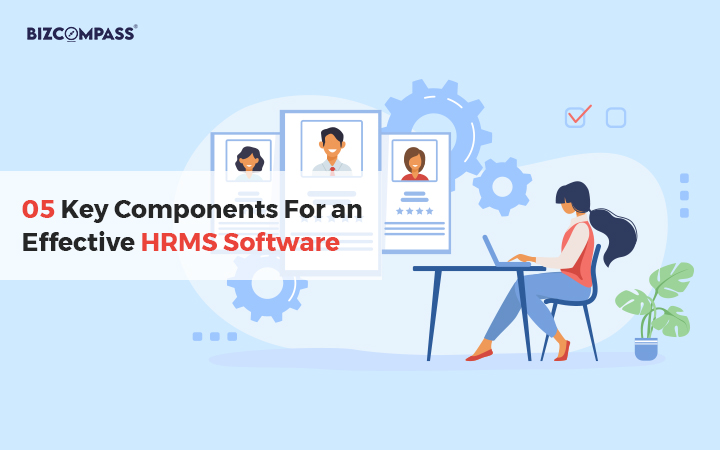
 >
>
